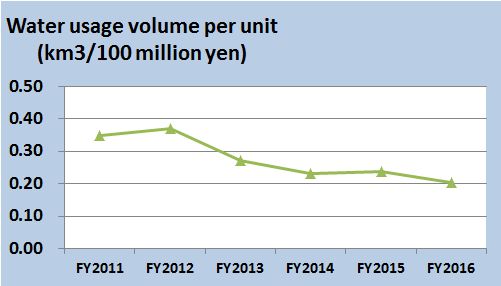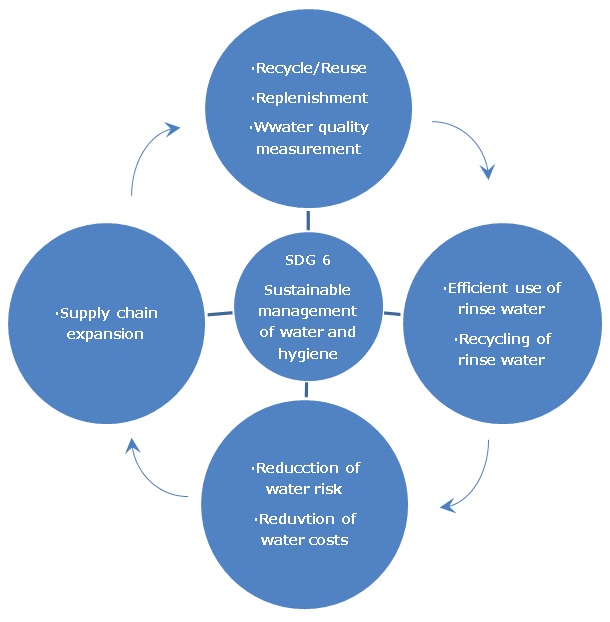Environmental Report 2017
Reduction of Materials and Resource Usage
Reducing Usage of Materials
In an effort to use materials more efficiently, we are working hard to reduce the amount (percentage) that becomes waste after being introduced into the manufacturing stage. Below, we will present efforts for the effective use of key materials at each site.●Efforts at JAE site
In order to reduce the volume of gold used in gold plating, JAE is making ongoing efforts to implement efficient improvements in such areas as the management of proper metal plating fields. In addition, to reduce the volume of materials used in machine processing, JAE is moving forward on purchasing in accordance with proper dimensions.
●Efforts at HAE site
HAE is focusing on reduction of the amount of materials used by reducing the width of metal materials used in presses and pin protection materials. The reduction of molding materials is being achieved by reducing unnecessary spoolers/runners (*use cursor to view definitions) that are discharged when extracting molded products; improving the number gates (*use cursor to view definitions), mold shape, and positioning when designing molds; and switching from cold runners to hot runners. This reduces the amount of molding material used, while using recycled materials promotes the continuous reduction in the cost of newly purchased material inputs and contributes to reducing waste material.
●Efforts at YAE site
Measures are underway for reducing the amount of materials used and waste generated by downsizing molds and revising the width of metal materials used in presses. In addition, increasing the rate of reuse of molding materials, reducing input materials by promoting closed-loop-recycling of product waste, and cutting down on the volume of materials used by making spoolers/runners more compact, result in significant CO2 reductions.
●Efforts at FAE site
Efforts to improve the reuse rate for copper alloy electrode material used in the manufacturing process for metal parts (discharge machining) are contributing to a reduction in the quantity of material used and the metal waste generated.
●Efforts at SAE site
The SAE site continues to focus on self-production of machined parts and reducing cutting processes. These efforts contribute to reduced metal waste, as well as lower CO2 emissions during material production.
Conservation of Water Resources
Japan may appear to be a country with abundant water resources, but it is actually said to be the world’s largest importer of virtual water(*use cursor to view definitions). Around the world, we see explosive population growth as well as drought and other abnormal weather conditions that result in many people being unable to obtain one-tenth of the daily water that a person requires.This section introduces a number of the activities of the JAE Group, both in and outside of Japan, designed to reduce the volume of water resources used, as well as other efforts, including forest preservation and river and shoreline cleanup activities.
- Water saving in production: recycling water in the connector product plating line, on/off controls for water usage on each cleaning line, and installing an evaporation prevention cover. Also limiting users in processes where large volumes of water are required for cleaning, and specialized faucets that are opened with keys.
- Water saving in lifestyle: adjusting water volume used in air conditioning cooling towers, recycling wastewater, using rainwater for toilets, using cooling tower drain water for toilets, changing from buried pipes that supply water for living to above-ground piping for the early detection of leaks and repair, and raising awareness of an important resource.
In line with these activities, at the JAE Group in Japan and at production sites in overseas locations, every year the volume of water used is being reduced. (The graph displays sales per unit.)
Monitor water risk and set water resource management goals
In recent years, as with global warming, “initiatives for sustainable water resource use” are called for as global issues, including the Sustainable Development Goals (SDGs) adopted at the United Nations in 2015.
In Japan, as mentioned above, we have a virtual water problem and the results of comprehensively assessed “qualitative, quantitative, regulatory and reputational” risks conducted using an assessment tool (*1) released by the World Resources Institute are shown below.
*1 WRI Aqueduct: A U.S. think tank that studies natural resource and environmental problems and makes policy recommendations. The Aqueduct tool was developed by the World Resources Institute.

We will present an example of the water resource management cycle and goals that we set based on this risk assessment.
- Improvement of consumption per unit of water
Target: Improvement on a per-unit basis 1%/year - Watershed replenishment/maintain water quality
Target: Replenishment by underground seepage tank
70,000 m3/year, and routine water quality measurement
Note: SDG 6, at the center of the chart, includes the water-related targets from among the 17 Sustainable Development Goals (SDGs) adopted at the United Nations.

